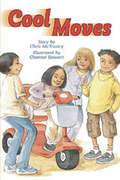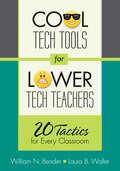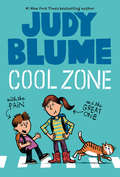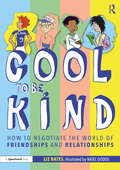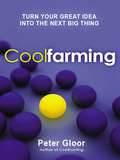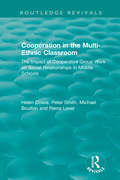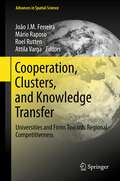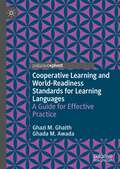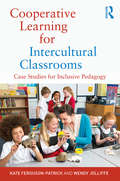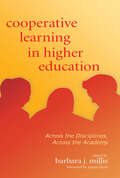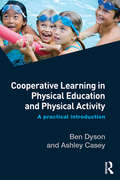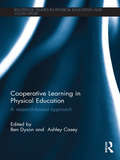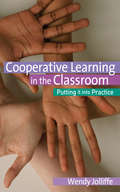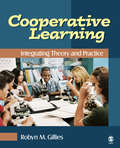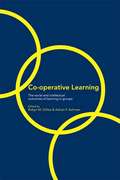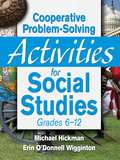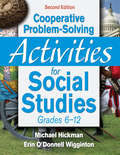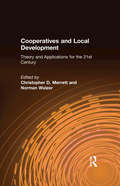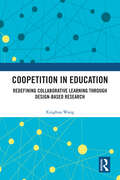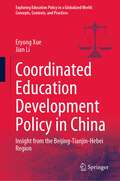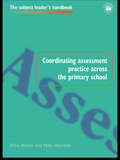- Table View
- List View
Cool Moves (Rigby PM Collection Sapphire (Levels 29-30), Fountas & Pinnell Select Collections Grade 3 Level Q)
by RigbyMelody Hope makes some really cool moves in her wheelchair--and some cool moves on the chessboard too! It's the final round of the chess competition, but things look grim when Melody's wheelchair mysteriously disappears. Can her friend Carlo get her to the final in time? And will it be "checkmate" for her opponent, Iggie Pike?
Cool Tech Tools for Lower Tech Teachers: 20 Tactics for Every Classroom
by William N. Bender Laura B. WallerMake the painless transition from low tech to tech friendly! If you're just making the transition to tech, this is the resource for you. In understandable language, this book describes how exactly you can use tools like webquests, wikis, social networking apps, and podcasts to enhance your lessons and keep kids engaged. The authors put technology within your reach by: Framing each tool in the context of what you need to know Defining the tool in easy-to-understand language; there’s no tech-speak Guiding you through implementation step by step Providing sample lesson plans to get you started
Cool Zone with the Pain and the Great One (Pain and the Great One Series)
by Judy Blume James StevensonTHE PAIN AND the Great One hardly agree on anything. But deep down, they know they can count on each other, especially at school, where it often takes two to figure things out. Like when that first baby tooth falls out on the school bus. Or when an unwanted visitor on Bring Your Pet to School Day needs to be caught. Or worst of all, when a scary bully says you're burnt toast. On days like these it can feel good not to go it alone. (And don't forget Fluzzy the cat, who knows a thing or two himself.)From the Hardcover edition.
Cool to be Kind: How to Negotiate the World of Friendships and Relationships
by Liz BatesThis illustrated storybook introduces Coco, Otto, Ollie and Ling as they negotiate the sometimes tricky world of friendships and relationships, observing the unkindness of some and using their superpower – kindness – to change the lives of others. Explore with them what it means to be unkind, why that choice is sometimes made and how usually there is another choice – to be kind. This storybook will: Help facilitate discussions with children about values, morals and empathy Support children to see that kindness can be a cool choice to make Help you to introduce children to the notion that kindness and unkindness are choices This book is available to purchase as part of a two-component set, Negotiating the World of Friendships and Relationships: A ‘Cool to be Kind’ Storybook and Practical Resource. It can be used by teachers and support staff to teach and promote kindness to children at primary age and beyond.
Coolfarming: Turn Your Great Idea into the Next Big Thing
by Peter GloorPursuing new ideas is clearly the way to gain business advantage in the new millennium. But it's not enough to simply chase after ideas that have already happened. To truly benefit, individuals and organizations have to foster the new creative impulses around them. Coolfarming shows readers how they, like bee keepers, can nurture exciting trends and unleash their creative swarm's output of "next big ideas." Featuring real life examples from Linux to Twilight, from Procter Gamble to Apple, Coolfarming provides readers with invaluable insight on how to: Provide a fertile nurturing ground for developing original ideas * Determine what "cool" means for one's target group, and what attributes the next big thing should possess * Convert creative dreams into real products by enlisting the help of a dedicated and passionate Collaborative Innovation Network * Carry new ideas over the tipping point into widespread phenomena Those who want to stay ahead of the curve and ride a wave of profit need to learn how to find, develop, and popularize the trends of tomorrow. Coolfarming is the answer.
Cooperation in the Multi-Ethnic Classroom: The Impact of Cooperative Group Work on Social Relationships in Middle Schools (Routledge Revivals)
by Peter Smith Helen Cowie Michael Boulton Rema LaverFirst published in 1994, this book describes how cooperative group work can enhance relationships in the classroom, reduce prejudice and alleviate problems of victimisation and peer rejection. It combines quantitative experimental analysis with detailed case studies; considers the impact of the family on pupil behaviour; and concludes with practical recommendations to foster social acceptance in the classroom. There is a strong emphasis on helping teachers to develop group work in their classrooms as an effective means of averting trouble and inducing a genuinely better attitude to collaboration with their fellow pupils. The difficulties in implementation which can arise if teachers are not motivated, or if pupils are disruptive, are honestly confronted. The book will also help educational and developmental psychologists involved in resolving behavioural difficulties resulting from social tensions in multi-ethnic classrooms.
Cooperation, Clusters, and Knowledge Transfer: Universities and Firms Towards Regional Competitiveness (Advances in Spatial Science #77)
by Attila Varga Roel Rutten Joao J Ferreira Mário RaposoCooperation and clusters have become the guiding paradigms for explaining and promoting regional competitiveness, but the cooperation process between firms and universities and the transfer of knowledge in guiding and nurturing regional competitiveness has received relatively little attention. This book strives to fill this gap in highlighting the connection between inter-firm cooperation in regional clusters, innovation and regional networks, and the role of universities in them . It goes beyond the traditional economic approach of clusters and includes 'soft factors' in the explanation of regional competitiveness, and connects the literature on clusters to the literature of learning and knowledge creation as sources of regional competitiveness. It aims to foster an international and interdisciplinary exchange of perspectives by presenting current developments, case studies, best practices as well as new integrated theoretical approaches and applications.
Cooperative Learning and World-Readiness Standards for Learning Languages: A Guide for Effective Practice
by Ghazi M. Ghaith Ghada M. AwadaThis book provides curriculum planners, materials developers, and language educators with curricular perspectives and classroom activities in order to address the needs of learners of English as a global lingua franca in an increasingly globalized and interdependent world. The authors argue that language educators would benefit from synthesizing and using research and evidence-based cooperative learning methods and structures to address the current world-readiness standards for learning languages in the five domains of Communication, Cultures, Connections, Comparisons, and Communities. The book outlines the main cooperative learning principles of heterogenous grouping, positive interdependence, individual accountability, social/collaborative skills, and group processing, then demonstrates their relevance to language teaching and learning. This book will be of interest to students in pre-service teacher education programmes as well as in-service practitioners, teacher trainers and educational administrators.
Cooperative Learning for Intercultural Classrooms: Case Studies for Inclusive Pedagogy
by Wendy Jolliffe Kate Ferguson-PatrickCooperative Learning for Intercultural Classrooms helps both pre-service and in-service teachers to develop a well-researched pedagogy that supports inclusive practice for a globalised world. It provides: an overview of theoretical perspectives that illustrate why cooperative learning is an effective learning strategy; reviews research findings about how cooperative learning supports inclusion; and outlines the strategies and methods that support teachers in putting cooperative learning into practice. Providing a step-by-step guide to implementing cooperative learning for schools, teachers and teacher educators, this invaluable resource includes: guidelines for a staged approach to implementation; case studies of cooperative learning in classrooms from a range of different contexts, including Australia, England, Sweden, Italy, India, Singapore and Hong Kong; guidance on developing an effective professional development programme for a school; appendices with valuable information on a range of cooperative learning structures and explanations of the main types of cooperative learning used in classrooms.
Cooperative Learning in Higher Education: Across the Disciplines, Across the Academy
by Barbara J. Millis James RhemResearch has identified cooperative learning as one of the ten High Impact Practices that improve student learning. If you’ve been interested in cooperative learning, but wondered how it would work in your discipline, this book provides the necessary theory, and a wide range of concrete examples.Experienced users of cooperative learning demonstrate how they use it in settings as varied as a developmental mathematics course at a community college, and graduate courses in history and the sciences, and how it works in small and large classes, as well as in hybrid and online environments. The authors describe the application of cooperative learning in biology, economics, educational psychology, financial accounting, general chemistry, and literature at remedial, introductory, and graduate levels.The chapters showcase cooperative learning in action, at the same time introducing the reader to major principles such as individual accountability, positive interdependence, heterogeneous teams, group processing, and social or leadership skills.The authors build upon, and cross-reference, each others’ chapters, describing particular methods and activities in detail. They explain how and why they may differ about specific practices while exemplifying reflective approaches to teaching that never fail to address important assessment issues.
Cooperative Learning in Physical Education and Physical Activity: A Practical Introduction
by Ashley Casey Ben DysonThis book introduces Cooperative Learning as a research-informed, practical way of engaging children and young people in lifelong physical activity. Written by authors with over 40 years’ experience as teachers and researchers, it addresses the practicalities of using Cooperative Learning in the teaching of physical education and physical activity at any age range. Cooperative Learning in Physical Education and Physical Activity will help teachers and students of physical education to master research-informed strategies for teaching. By using school-based and real-world examples, it allows teachers to quickly understand the educational benefits of Cooperative Learning. Divided into four parts, this book provides insight into: Key aspects of Cooperative Learning as a pedagogical practice in physical education and physical activity Strategies for implementing Cooperative Learning at Elementary School level Approaches to using Cooperative Learning at Middle and High School level The challenges and advantages of practising Cooperative Learning Including lesson plans, activities and tasks, this is the first comprehensive guide to Cooperative Learning as a pedagogical practice for physical educators. It is essential reading for all students, teachers and trainee teachers of physical education and will also benefit coaches, outdoor educators and people who work with youth in the community.
Cooperative Learning in Physical Education: A research based approach (Routledge Studies in Physical Education and Youth Sport)
by Ashley Casey Ben DysonCooperative Learning is a dynamic instructional model that can teach diverse content to students at different grade levels, with students working together in small, structured, heterogeneous groups to master subject content. It has a strong research tradition, is used frequently as a professional development tool in general education and is now emerging in physical education. This book defines Cooperative Learning in physical education and examines how to implement Cooperative Learning in a variety of educational settings. It explores Cooperative Learning in physical education from three main perspectives. The first, context of learning, provides descriptions of Cooperative Learning in different levels of education (elementary school, secondary school, and university physical education). The second, Cooperative Learning in the curriculum, offers case studies from teachers and researchers of their experiences of implementing Cooperative Learning within their own national context. The third perspective, key aspects of Cooperative Learning, examines how the different elements of the model have been foregrounded in efforts to enhance learning in physical education.As the only text to provide international perspectives, from eight different countries, of Cooperative Learning in physical education, this book is important reading for any student, researcher or teacher with an interest in physical education, sport education, sport pedagogy, curriculum development or methods for learning and teaching.
Cooperative Learning in the Classroom: Putting it into Practice
by Wendy Jolliffe'What is cooperative learning? Why should teachers use it in the classroom? What are the benefits? In eight accessible chapters, Wendy Jolliffe, lecturer in primary education at Hull University, outlines the theory and practice of cooperative learning and shows how the "outcomes and aims of Every Child Matters (2004) can be clearly mapped to the advantages of cooperative learning."... A useful resource for teachers, headteachers, trainee teachers and support staff' - Learning and Teaching Update Cooperative Learning is about structuring lesson activities to encourage pupils to work collaboratively in pairs or small groups to support each other to improve their learning. This inclusive approach to teaching is very much in tune with current initiatives such as Every Child Matters and Excellence and Enjoyment and the focus on learning styles. This book is an accessible guide to implementing cooperative learning in the classroom. It includes: " an explanation of the key factors that make cooperative learning work " a step-by-step approach to implementing cooperative learning in the classroom " advice on how to measure the effectiveness of cooperative learning " guidance for using cooperative learning to encourage effective talk " links to supporting children's emotional intelligence " ideas for practical activities " an action plan and programme for whole school professional development The book is an invaluable resource for individual teachers using cooperative learning techniques in classrooms, this book will also be of interest to headteachers, trainee teachers and learning support staff.
Cooperative Learning: A Standard for High Achievement
by R. Bruce WilliamsThis practical guidebook demonstrates how to integrate six critical elements—reflection, individual achievement, collaboration, higher-order thinking, emotional realms, and social skills—into robust cooperative learning tasks.
Cooperative Learning: Integrating Theory and Practice
by Robyn M. GilliesAlthough cooperative learning is widely endorsed as a pedagogical practice that promotes learning and socialization among students, teachers still struggle with how to introduce it into their classrooms. This text highlights the strategies teachers can use to challenge student thinking and scaffold their learning as well as the strategies students can be taught to promote discourse, problem—solving, and learning during cooperative learning. This is an excellent supplementary text for several undergraduate and graduate level K—12 teacher preparation and certification courses regularly offered in schools of education. It can also be used as one of several texts in courses on cooperative learning and as a supplement in K—12 teaching methods courses.
Cooperative Learning: The Social and Intellectual Outcomes of Learning in Groups
by Robyn M. Gillies Adrian F. AshmanThis book recognizes the importance of cooperative learning, in contrast to the traditional classroom, as an effective approach to learning. Its coverage of the subject ranges across the educational spectrum, from pre-school years to university, and offers a fresh perspective on a topic that has gained increasing interest worldwide.With contributions from an international panel of leading experts in the field, this engaging text succeeds in providing key insights, linking the theories that underpin the study of group dynamics to their practical application in the classroom. It presents a comprehensive overview of this alternative educative approach, illustrating how cooperative learning experiences can promote socialisation and friendships, and facilitate learning. The editors assemble a range of well-researched essays, covering such aspects as:* The importance of teacher and student interaction* Small group, virtual and non-virtual teaching environments* Assessment practices for measuring the outcomes of individual and group progress* The effect of cooperative learning on relationships amongst students with diverse cultural, social and learning needs.Illustrated with practical examples throughout, this book will be a crucial read for teacher educators, educational psychologists, student teachers, academics and researchers who want to realize the significant potential of cooperative learning in all educational settings.
Cooperative Problem-Solving Activities for Social Studies Grades 612
by Michael Hickman Erin O. WiggintonGive your students the opportunity to think, discover, and learn together in social studies!Teamwork helps students strengthen individual retention, improve performance, and promote meaning-making in the classroom. To give adolescent minds practice in critical thinking, the authors use their considerable teaching experience to present more than 40 problem-solving activities that are ready for immediate use in the social studies classroom.This updated edition of Catch Them Thinking in Social Studies demonstrates how to use collaborative learning strategies to fully engage students in meaning-making. Cooperative Problem-Solving Activities for Social Studies, Grades 6-12 offers lessons in five areas of social studies instruction: geography, politics, economics, culture, and history. Each activity includes background information, clue cards, objectives, tasks, and worksheets. This updated edition helps teachers: Develop students' decision-making, analysis, and communication skills Foster teamwork and interdependent learning Construct cooperative problem-solving activities using their own curriculumThrough the activities in this book, students will work together to learn about social topics while developing important, real-world skills. Featuring current research and new activities, this hands-on resource helps teachers facilitate cooperative problem solving in social studies and provides teacher tips throughout the book.
Cooperative Problem-Solving Activities for Social Studies, Grades 6-12
by Dr Michael Hickman Dr Erin O'Donell WiggintonFeaturing current research and new activities, the second edition offers collaborative learning strategies and more than 40 ready-to-use lessons to fully engage students in social studies.
Cooperative and Work-Integrated Education in Asia: History, Present and Future Issues (Routledge Research in International and Comparative Education)
by Yasushi Tanaka Karsten ZegwaardIt has been over a century since "Cooperative System of Education," a work-study programme for higher education, was initiated by Herman Schneider at University of Cincinnati in the United States. Today, it is known as "Cooperative Education" which is commonly included within the umbrella term of "Work-Integrated Learning" and broadly referred to by the World Association of Cooperative Education (WACE) as "Cooperative and Work- Integrated Education (CWIE)". Its development worldwide has been closely related to the socioeconomic background of the region. This book offers the first attempt to focus on the development of CWIE in Asia. To date, the development of CWIE in the Asia region has been slow compared to their counterparts. The analysis follows international comparisons of China, Japan, Korea, Hong Kong, Vietnam, Thailand, Malaysia, and Singapore on their educational history, vocational education, CWIE, and future issues. Although the level of development varies among them, there is no doubt that this region as a whole is experiencing a rapidly growing global demographic and economic prominence. CWIE can, and to some extent already does, play an important, supportive role as part of growth. The book goes on to conclude that in order to enable further successful expansion of CWIE, and improve its best practice, it is imperative to establish national and regional associations for CWIE, as well as establish collaborative research activities across the region with governmental funding support.
Cooperatives and Local Development: Theory and Applications for the 21st Century
by Norman Walzer Christopher D. MerrettFirst Published in 2004. Routledge is an imprint of Taylor & Francis, an Informa company.
Coopetition for Regional Competitiveness: The Role of Academe in Knowledge-Based Industrial Clustering (SpringerBriefs in Education #0)
by Jomphong MongkhonvanitThis book investigates the roles of industrial clustering and of tertiary educational institutions in the development of industrial clusters and competitiveness. It examines the concept of regional development through industrial clustering to understand the relationships and factors influencing coopetition (cooperation and competition) between government, companies and tertiary educational institutions. In addition, the book proposes applicable models and methods for improving the dynamics of government, tertiary education, national research institutes and firms in order to improve the skills, knowledge, innovation and competitiveness of industrial clusters, using Thailand's automotive cluster as a central case study.
Coopetition in Education: Redefining Collaborative Learning through Design-Based Research
by Xinghua WangThe book explores the development of coopetition designs aimed at enhancing student collaborative learning, addressing persistent challenges such as low individual accountability and the associated free-rider issue.Moving beyond the long-standing and inconclusive debates between collaboration and competition, the book embraces the concept of coopetition—a hybrid approach that merges the strengths of both collaboration and competition while mitigating their respective weaknesses. The author develops two initial coopetition designs: social-comparison coopetition and zero-sum coopetition, both of which underwent rigorous examination and refinement through three iterative research cycles, followed by the design-based research methodology. He reveals that social-comparison coopetition consistently outperformed other designs across all cycles, demonstrating enhanced student motivation, engagement, and self-regulated learning. By contrast, while zero-sum coopetition showed slight advantages in one-off applications, its repeated use required careful handling. In conclusion, the book introduces two key design principles that define the core components and appropriate contexts for implementing coopetition, with a particular emphasis on social-comparison coopetition.The book will be valuable for researchers, educators, and teachers looking for new theories and strategies to enhance collaborative learning.
Coordinated Education Development Policy in China: Insight from the Beijing-Tianjin-Hebei Region (Exploring Education Policy in a Globalized World: Concepts, Contexts, and Practices)
by Jian Li Eryong XueThis book examines educational resource allocation in Beijing, the allocation of educational resources in student resource optimization analysis in Tianjin, educational resource allocation in Hebei Province, and the optimal allocation of vocational education resources in Beijing, Tianjin, and Hebei. It also offers a holistic landscape of exploring coordinated education development historically. This book has interdisciplinary appeal and is of interest to all studying and researching Chinese educational policy.
Coordinating Art Across the Primary School (Subject Leaders' Handbooks)
by Robert Clement Judith Piotrowski Ivy RobertsSpecifically designed for busy teachers who have responsibility for co-ordinating a subject area within their primary school. Each volume in the series conforms to a concise style, while providing a wealth of tips, case studies and photocopiable material that teachers can use immediately.; There are special volumes dedicated to dealing with OFSTED, creating whole school policy and the demands of co-ordinating several subjects within a small school.; The entire set of 16 volumes is available.
Coordinating Assessment Practice Across the Primary School (Subject Leaders' Handbooks)
by Mr Mike Harrison Mike Harrison Mike WintleThis book is specifically designed for busy teachers who have responsibility for co-ordinating a subject area within their primary school. Each volume in the series conforms to a concise style, while providing a wealth of tips, case studies and photocopiable material that teachers can use immediately. There are special volumes dedicated to dealing with Ofsted, creating whole school policy and the demands of co-ordinating several subjects within a small school. The entire set of 16 volumes is available from RoutledgeFalmer and details of the series can be seen on our website.
